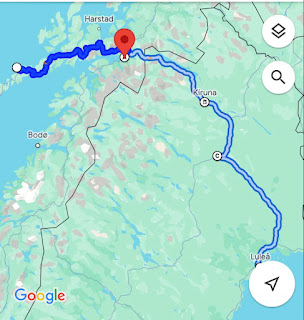How hard can it be?
It is said that there is one thing harder than climbing Mount Everest and that is getting safely down again. Heading homeward from the Lofoten Islands we knew was going to be a bit tricky. We generally like to have things booked ahead, but for much of the onward journey from Lofoten booking ahead was not possible. How hard could it be?
Our plan started simple. Monday return the hire car to Svolvear and then catch a local three and half hour bus, via a bridge to the mainland, to arrive at Narvik. Though we had seen bus shelters all over the Islands for some reason the bus stop at Svolvear is just a post on the side of the road, but the rain abates, and a crowd appears waiting for the bus. We buy tickets on board the Route 900 bus. The trip is scenic, and a little hair raising as the driver hurtles along the windy road that hugs the dramatic fjord coastline of Lofoten.
Next day our plan was to take an eight hour train journey from Narvik, Norway to Lulea, Sweden. The plan was to skirt around the top of the Gulf of Bothnia on route to Helsinki thus avoiding another long ferry trip. For weeks we have been attempting to buy this ticket online and after repeated emails back and forth the railway insisted that they had yet to release the summer tickets. At a deserted Narvik railway station it becomes obvious that something is not right. The Norwegian railway system tells us that the train we are hoping to catch is run by the Swedish Railway, but despite our repeated attempts to find out more information they are not answering their phone. After much digging we find an obscure note online saying that the train won’t run because of track damage and will be replaced by a bus for the first four hours of the route.
Tuesday morning, we arrive at the station and are somewhat comforted to see fellow travellers all equally confused yet hopeful. Thankfully (because we didn’t have a plan B) a bus arrives but it’s only going 3 hours to Kiruna (the centre of iron ore mining in Europe, not exactly a tourist’s trap). At Kiruna we are greeted by another slightly smaller bus, which after two hours, delivers us to Gallivare railway station and the welcome sight of a somewhat dated looking train. We imagine the worst is behind us. Then an announcement comes, the train is delayed:10 minutes, 30, then 50 and eventually, indefinitely. The station is crowded with those of us who have travelled on the bus from Kiruna and locals who share with us their lack of confidence in the privatised Swedish Rail system.
After about 90 minutes with the assistance of a fellow traveller from the UK (Alistair) we spot the guard and driver getting off the train and walking in our direction. Our hearts lift and we walk to greet them, only to see them detour to buy an ice cream. It is quite a hot day. As they eat their ice cream, we politely question them, and the conversation goes like this.
“Do you know when the train is leaving” asks Richard, ever so politely.
“We can’t go until the bus from Kiruna arrives” replies the train guard.
“We (all these people) are from the bus from Kiruna “
“No!” says the guard “We need to wait for the bus from Kiruna”.
“NO! WE HAVE BEEN HERE FOR 90 MINUES- WE ARE FROM THE BUS FROM KIRUNA” says a slightly exasperated Richard.
“Oh, if that’s the case then board the train and let’s get out of this sh_t hole” says the train driver.
However, the train is several hundred metres from where it had been announced that we should board so Alistair asks, “Will you bring the train forward so we can board?”
“No, you have legs you can walk!” barks the driver.
Sometimes reality is stranger, weirder and looking back funnier than fiction.
The next day was also going to be tricky as we cross the border to Finland, but tonight (in Everest terms) we are back to base camp (in Sweden). We don’t have tickets, but do have a plan, which according to various websites should work. How hard could it be?






Comments
Post a Comment